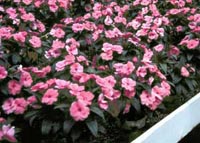Resource Library
Plant of the Week: Sultana (Impatiens)
The University of Arkansas System Division of Agriculture does not promote, support or recommend plants featured in "Plant of the Week." Please consult your local Extension office for plants suitable for your region.
Plant of the Week
Sultana, Impatiens
Latin: Impatiens wallerana

What can I get that will flower in the shade? As gardeners we are faced with this
question more and more each year as our landscapes mature and our gardens get more
shady. The garden impatiens has emerged to answer the need, providing a wide array
of flower colors and plant sizes for every garden situation. The rise of the garden
impatiens to become the most popular bedding plant species during the last decade
largely is due to the efforts of one man, yet even among well- informed gardeners,
few know of him or of his accomplishments.
The man responsible for propelling impatiens into the spotlight is Claude Hope, whose
firm, PanAmerican Seed Company, is located in Dulce Nombre in central Costa Rica.
Hope grew up in Sweetwater, Texas, but discovered Costa Rica during World War II when
the Army assigned him the task of establishing New World plantations of Cinchona,
the plant from which quinine is extracted.
After the war Hope returned to Costa Rica with the dream of becoming a flower breeder.
He was well equipped for the task with horticultural degrees from Texas Tech and Michigan
State. When he arrived in Costa Rica he discovered a tall, gangly weed he didn’t recognize
growing in the fence rows. The weed turned out to be impatiens that had escaped cultivation
after being introduced to the country prior to 1880.
Impatiens, so named because the seed capsule will erupt and expel the seeds while
still green, was originally collected in Zanzibar in Central Africa in 1865. Originally
named I. sultana in honor of the Sultan of Zanzibar, the name was finally revised
to I. walleriana to honor Horace Waller, the missionary who saw to the publication
of Dr. David Livingstone’s journal of "Dr. Livingstone I presume" fame after Livingstone
died in the bush in 1873. The early name stuck and the common name "sultana" became
popular for the plant.
Hope began improving impatiens in the mid-1950s, and by 1965 he had a series of eight
selections in field trials in the United States. In 1968, he released the Elfin series,
the first dwarf, free-flowering forms. He continued to improve impatiens over the
years. Today, the firm he established, which was sold to Ball Seed Company of West
Chicago, Ill., in 1980, controls 60 percent of the world’s impatiens seed market.
The firm has grown to 400 acres. One-hundred acres are under polyethylene tents,
where the flowers are individually pollinated by hand to produce the hybrid seeds.
Hope has been called the 20th century’s most important flower breeder, yet he is
largely unknown, even in horticultural circles.
Impatiens are available in a wide array of colors from red to pink, rose, lavender,
white and assorted bicolor combinations. The plants are all free-branching and usually
under 14 inches tall, unless they’re planted too close together. If cuttings are taken
from upright growth at the top of a plant, the resulting plants will grow upright
and taller than the original plant.
The popularity of impatiens in the garden is due to their ability to flower in the
shade, and because they are easy to grow. The plants will tolerate morning sun, but
by noon they need to be in the shade or the summer sun will cook them. Impatiens do
best when given a well-prepared, relatively fertile soil that can be kept on the moist
side during the summer.
While impatiens will not grow in standing water, uniformly moist conditions just
short of standing water seem to be their preference. Impatiens will often reseed in
future years, but the seedlings will come back in mixed colors of pink, white and
rose. Few serious insect or disease pests bother impatiens.
By: Gerald Klingaman, retired
Extension Horticulturist - Ornamentals
Extension News - June 2, 2000
The University of Arkansas System Division of Agriculture does not maintain lists of retail outlets where these plants can be purchased. Please check your local nursery or other retail outlets to ask about the availability of these plants for your growing area.